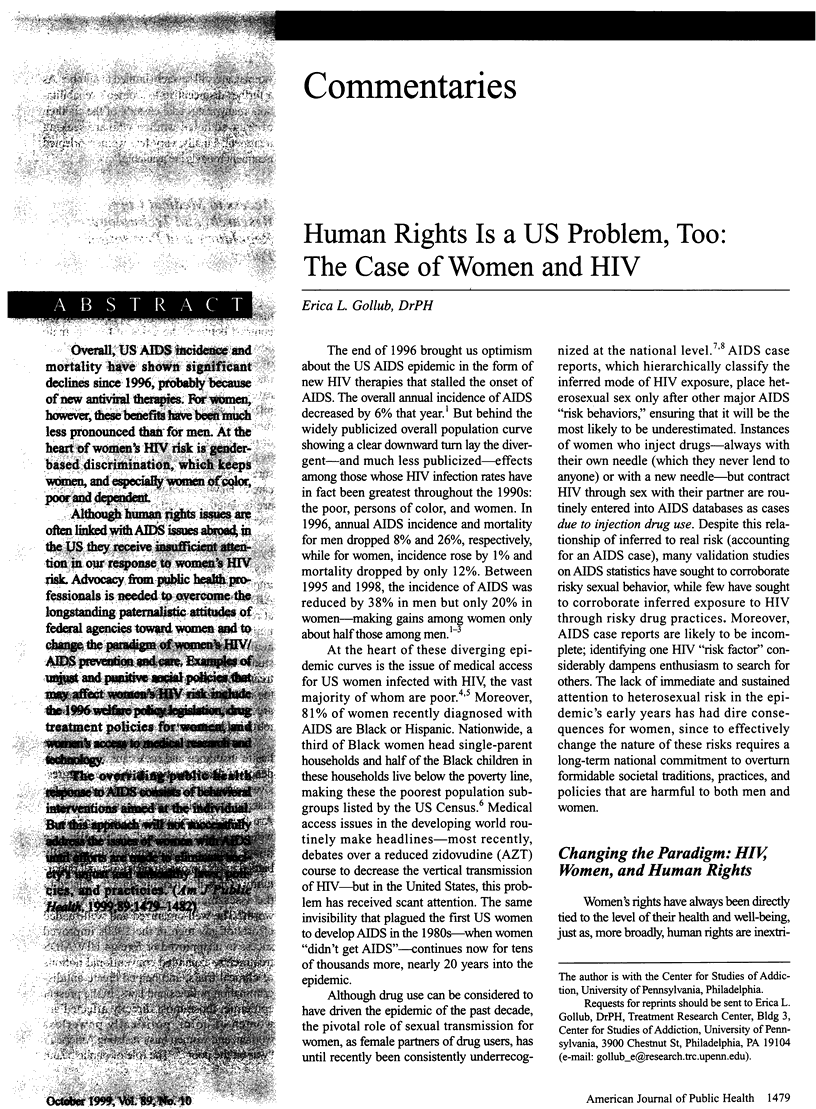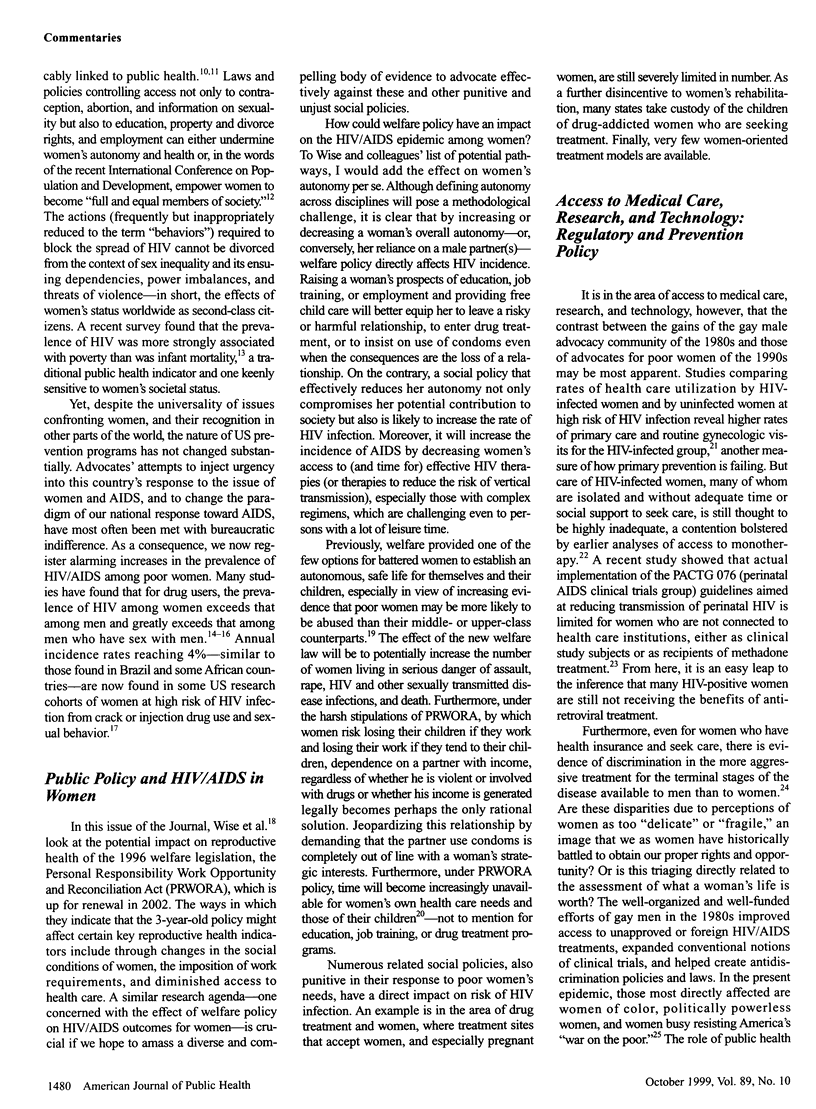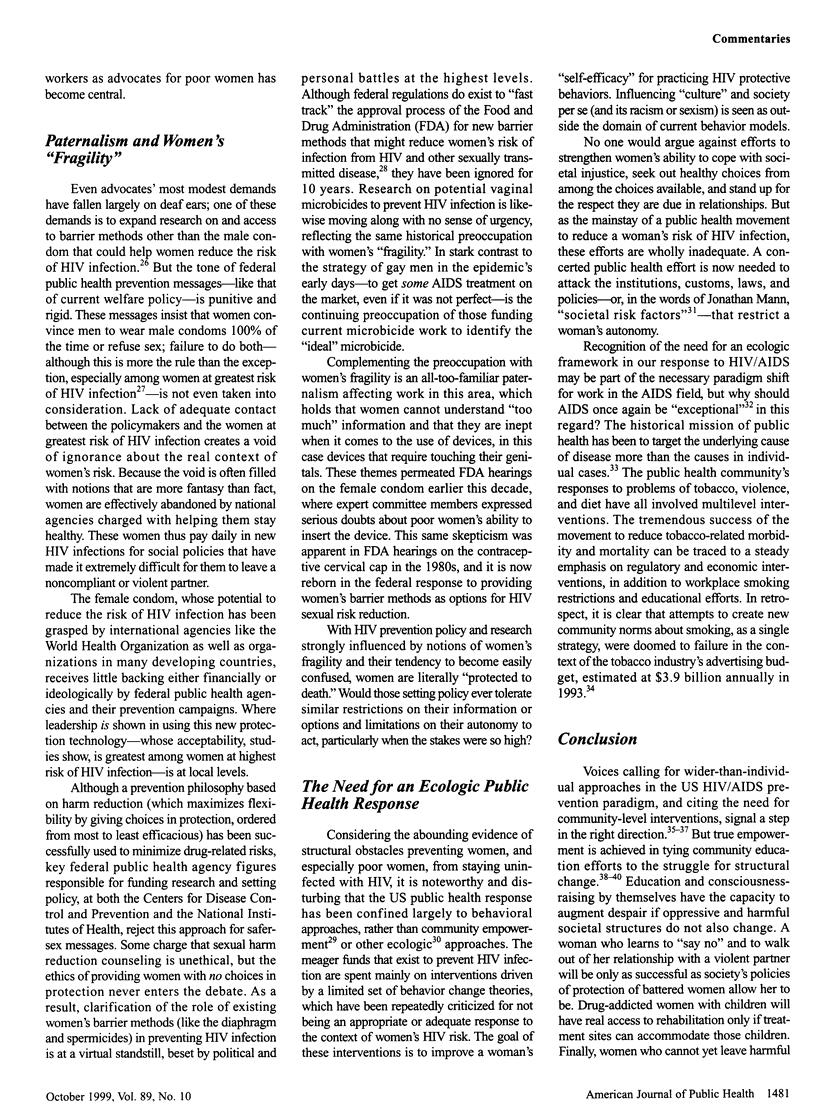Abstract
Overall, US AIDS incidence and mortality have shown significant declines since 1996, probably because of new antiviral therapies. For women, however, these benefits have been much less pronounced than for men. At the heart of women's HIV risk is gender-based discrimination, which keeps women, and especially women of color, poor and dependent. Although human rights issues are often linked with AIDS issues abroad, in the US they receive insufficient attention in our response to women's HIV risk. Advocacy from public health professionals is needed to overcome the longstanding paternalistic attitudes of federal agencies toward women and to change the paradigm of women's HIV/AIDS prevention and care. Examples of unjust and punitive social policies that may affect women's HIV risk include the 1996 welfare policy legislation, drug treatment policies for women, and women's access to medical research and technology. The overriding public health response to AIDS consists of behavioral interventions aimed at the individual. But this approach will not successfully address the issues of women with AIDS until efforts are made to eliminate society's unjust and unhealthy laws, policies, and practicles.
Full text
PDF



Selected References
These references are in PubMed. This may not be the complete list of references from this article.
- Bayer R. Public health policy and the AIDS epidemic. An end to HIV exceptionalism? N Engl J Med. 1991 May 23;324(21):1500–1504. doi: 10.1056/NEJM199105233242111. [DOI] [PubMed] [Google Scholar]
- Beeker C., Guenther-Grey C., Raj A. Community empowerment paradigm drift and the primary prevention of HIV/AIDS. Soc Sci Med. 1998 Apr;46(7):831–842. doi: 10.1016/s0277-9536(97)00208-6. [DOI] [PubMed] [Google Scholar]
- Des Jarlais D. C., Friedman S. R., Friedmann P., Wenston J., Sotheran J. L., Choopanya K., Vanichseni S., Raktham S., Goldberg D., Frischer M. HIV/AIDS-related behavior change among injecting drug users in different national settings. AIDS. 1995 Jun;9(6):611–617. doi: 10.1097/00002030-199506000-00013. [DOI] [PubMed] [Google Scholar]
- Farmer P. Pathologies of power: rethinking health and human rights. Am J Public Health. 1999 Oct;89(10):1486–1496. doi: 10.2105/ajph.89.10.1486. [DOI] [PMC free article] [PubMed] [Google Scholar]
- Fife D., Mode C. AIDS incidence and income. J Acquir Immune Defic Syndr. 1992;5(11):1105–1110. [PubMed] [Google Scholar]
- Heise L. L., Elias C. Transforming aids prevention to meet women's needs: a focus on developing countries. Soc Sci Med. 1995 Apr;40(7):931–943. doi: 10.1016/0277-9536(94)00165-p. [DOI] [PubMed] [Google Scholar]
- Heymann S. J., Earle A. The impact of welfare reform on parents' ability to care for their children's health. Am J Public Health. 1999 Apr;89(4):502–505. doi: 10.2105/ajph.89.4.502. [DOI] [PMC free article] [PubMed] [Google Scholar]
- Kelly J. A. Community-level interventions are needed to prevent new HIV infections. Am J Public Health. 1999 Mar;89(3):299–301. doi: 10.2105/ajph.89.3.299. [DOI] [PMC free article] [PubMed] [Google Scholar]
- Klevens R. M., Fleming P. L., Neal J. J., Li J. Is there really a heterosexual AIDS epidemic in the United States? Findings from a multisite validation study, 1992-1995. Mode of Transmission Validation Study Group. Am J Epidemiol. 1999 Jan 1;149(1):75–84. doi: 10.1093/oxfordjournals.aje.a009730. [DOI] [PubMed] [Google Scholar]
- Kral A. H., Bluthenthal R. N., Booth R. E., Watters J. K. HIV seroprevalence among street-recruited injection drug and crack cocaine users in 16 US municipalities. Am J Public Health. 1998 Jan;88(1):108–113. doi: 10.2105/ajph.88.1.108. [DOI] [PMC free article] [PubMed] [Google Scholar]
- Mann J. M. We are all Berliners: notes from the Ninth International Conference on AIDS. Am J Public Health. 1993 Oct;83(10):1378–1379. doi: 10.2105/ajph.83.10.1378. [DOI] [PMC free article] [PubMed] [Google Scholar]
- McLeroy K. R., Bibeau D., Steckler A., Glanz K. An ecological perspective on health promotion programs. Health Educ Q. 1988 Winter;15(4):351–377. doi: 10.1177/109019818801500401. [DOI] [PubMed] [Google Scholar]
- Nwanyanwu O. C., Conti L. A., Ciesielski C. A., Stehr-Green J. K., Berkelman R. L., Lieb S., Witte J. J. Increasing frequency of heterosexually transmitted AIDS in southern Florida: artifact or reality? Am J Public Health. 1993 Apr;83(4):571–573. doi: 10.2105/ajph.83.4.571. [DOI] [PMC free article] [PubMed] [Google Scholar]
- Prevots D. R., Allen D. M., Lehman J. S., Green T. A., Petersen L. R., Gwinn M. Trends in human immunodeficiency virus seroprevalence among injection drug users entering drug treatment centers, United States, 1988-1993. Am J Epidemiol. 1996 Apr 1;143(7):733–742. doi: 10.1093/oxfordjournals.aje.a008807. [DOI] [PubMed] [Google Scholar]
- Rose G. Sick individuals and sick populations. Int J Epidemiol. 1985 Mar;14(1):32–38. doi: 10.1093/ije/14.1.32. [DOI] [PubMed] [Google Scholar]
- Shopland D. R. Smoking control in the 1990s: a national cancer institute model for change. Am J Public Health. 1993 Sep;83(9):1208–1210. doi: 10.2105/ajph.83.9.1208. [DOI] [PMC free article] [PubMed] [Google Scholar]
- Simon P. A., Hu D. J., Diaz T., Kerndt P. R. Income and AIDS rates in Los Angeles County. AIDS. 1995 Mar;9(3):281–284. [PubMed] [Google Scholar]
- Solomon L., Stein M., Flynn C., Schuman P., Schoenbaum E., Moore J., Holmberg S., Graham N. M. Health services use by urban women with or at risk for HIV-1 infection: the HIV Epidemiology Research Study (HERS). J Acquir Immune Defic Syndr Hum Retrovirol. 1998 Mar 1;17(3):253–261. doi: 10.1097/00042560-199803010-00011. [DOI] [PubMed] [Google Scholar]
- Stein M. D., Piette J., Mor V., Wachtel T. J., Fleishman J., Mayer K. H., Carpenter C. C. Differences in access to zidovudine (AZT) among symptomatic HIV-infected persons. J Gen Intern Med. 1991 Jan-Feb;6(1):35–40. doi: 10.1007/BF02599388. [DOI] [PubMed] [Google Scholar]
- Stein Z. A. HIV prevention: the need for methods women can use. Am J Public Health. 1990 Apr;80(4):460–462. doi: 10.2105/ajph.80.4.460. [DOI] [PMC free article] [PubMed] [Google Scholar]
- Stein Z., Susser M. Annotation: prevention of HIV, other sexually transmitted diseases, and unwanted pregnancy--testing physical barriers available to women. Am J Public Health. 1998 Jun;88(6):872–874. doi: 10.2105/ajph.88.6.872. [DOI] [PMC free article] [PubMed] [Google Scholar]
- Turner B. J., Newschaffer C. J., Zhang D., Fanning T., Hauck W. W. Translating clinical trial results into practice: the effect of an AIDS clinical trial on prescribed antiretroviral therapy for HIV-infected pregnant women. Ann Intern Med. 1999 Jun 15;130(12):979–986. doi: 10.7326/0003-4819-130-12-199906150-00005. [DOI] [PubMed] [Google Scholar]
- Wallerstein N. Powerlessness, empowerment, and health: implications for health promotion programs. Am J Health Promot. 1992 Jan-Feb;6(3):197–205. doi: 10.4278/0890-1171-6.3.197. [DOI] [PubMed] [Google Scholar]
- Wise P., Chavkin W., Romero D. Assessing the effects of welfare reform policies on reproductive and infant health. Am J Public Health. 1999 Oct;89(10):1514–1521. doi: 10.2105/ajph.89.10.1514. [DOI] [PMC free article] [PubMed] [Google Scholar]
- Wortley P. M., Fleming P. L. AIDS in women in the United States. Recent trends. JAMA. 1997 Sep 17;278(11):911–916. [PubMed] [Google Scholar]


